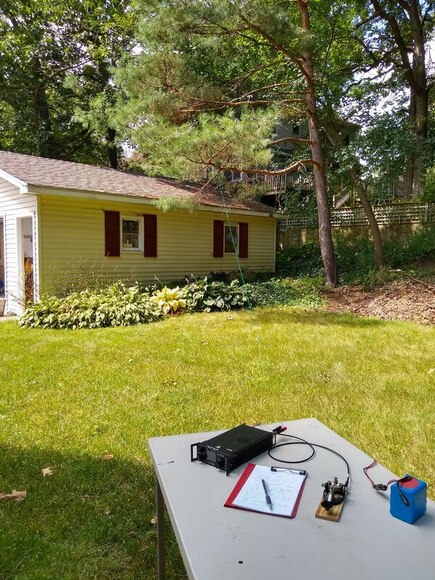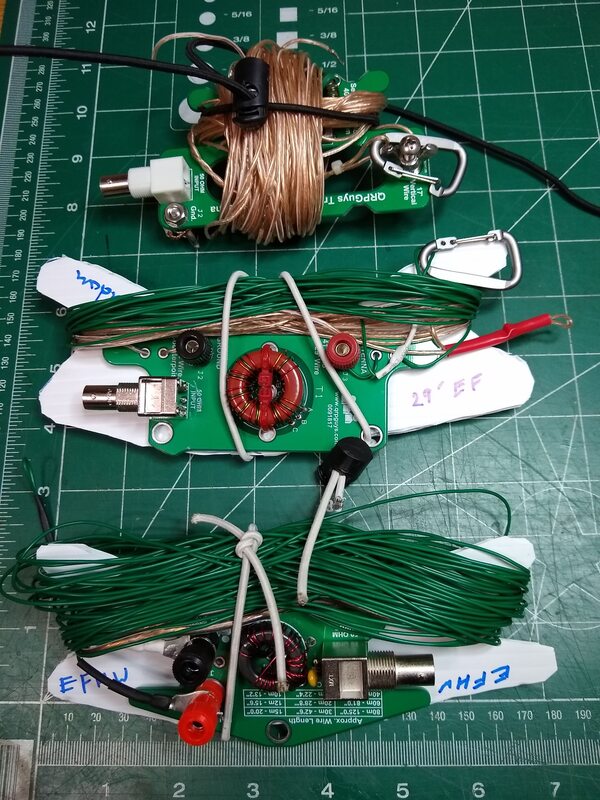End Fed Antennas
Basic Description of End Fed Antennas
A very simple antenna to make, deploy and use is an end fed wire antenna. The number of variations are endless. Probably the most familiar is the end fed half wave antenna (EFHW) But random length or non-resonant end fed antennas are also popular and effective, especially for portable use. Both can be used on multiple bands though the random length one may have a slight advantage there if you have a tuner. Just a note, as with most antennas, you will find more opinions about end fed's than there are people to have them. My advice is, try them. What works for you in a particular situation is what is important.
As most authors note, random length doesn't generally mean just any length with the issue being that the wire shouldn't be resonant on any desired frequency. Some often used lengths are 29ft, 35.5 ft, 51 ft and 84 ft..
Most include 4:1, 9:1, 49:1 or other transformer, balun or unun attached between the antenna and a coax feedline which in turn goes to a tuner or directly to the radio. However, depending on the capability of your tuner you may be able to attach the radiator and counterpoise directly to the tuner and avoid the unun. Except for the EFHW a counterpoise is always necessary. The length of the counterpoise is not critical. I have found that a 17 ft counterpoise works well with a 29 ft radiator. An end fed antenna whether random or resonant can be set up in various configurations such as a sloper, a vertical, inverted L, etc. making them very convenient and attractive. They are particularly suited for use in portable situations.
A special case of the end fed antenna is the end fed half wave antenna. It is essentially a half wave length of wire fed at one end rather than in the middle as would be the case with a dipole. Its radiation characteristics are similar to a half wave dipole. They have to main attractions: 1) ease of setting up and feeding since only one support for the far end is essential. The driven end can literally be just inches or feet off the ground. 2) they can be used without a tuner on all harmonically related bands above the design band. So one cut for 40 meters can be used with no tuner on 40, 20, 15 and 10 meters. A negative is that they generally require a transformer, typically a 49:1 transformer to bring the approximately 2500 ohms impedance at the feed end down to 50 ohms. My experience is that transformer is a small price to pay for a very convenient and effective antenna. I currently use an mfj 1984MP, 40-10 efhw as my primary home station antenna. It replaces a G5RV which has served me very well for many years and may go back up again.
My Favorite Portable End Fed Antennas
2019-11-01 After playing with various half wave and "random" end fed antennas for QRP power levels for several months and having to take down my trusty G5RV, I bought an MFJ-1984MP End Fed Half Wave which is now my home station antenna and I really like it. But I wanted share what I believe are my three favorite end fed options, primarily for portable QRP use though I have used all three as my home station antennas as well.
2019-10-30 I think my three favorite portable wire antennas are based on QRPGuys ununs and are pictured below. Top: QRPGuys 17', three band vertical. Center: QRPGuys 29' random wire. Bottom: QRPGuys 40-10meter End Fed half Wave. All you need to deploy any one of them is a coax cable and either a push up mast or a tree to string them from. A big advantage to all three is they only require a single support.
|
Three Band Vertical. My third choice would be the three band vertical. It is comparable with the 29' antenna in terms of setting it up though it require at least four radials. Once you get it "tuned" during construction it should not require a tuner.
It is limited to just 40, 30 and 20 meters with 20 being its "native" band since the 17' radiating element is a 1/4 wave on 20. I think that means it will be less effective on both 30 and 40, but I have had QSOs on all three bands. Its main disadvantage, compared to the other two, is that to change bands you have to physically flip the switches on the antenna itself to select the proper loading coil for the band of choice. Since it is resonant on 20 meters you switch out both coils for 20. Its main advantage is space required. Seventeen feet of vertical space is all you need! Well, a few feet surrounding the base for the four ten foot radials. For details of mine, click here.
Conclusion. I've played with all three antennas and they are all reasonable options. Selection will likely be based on the physical situation where you want to set up and how much "stuff" you want to pack and carry. None of them will leave you high and dry!
|
EFHW. Of the three the "best" performer and my overall favorite is the 40-10 meter end fed half wave antenna. If you can deploy the approximately 66' wire either as a sloper, inverted L or inverted vee with the feedpoint within easy reach of your radio, it will do a great job. I've played with both the sloper and inverted vee and can't say I noticed any on-air difference. An aluminum tent peg or other earth "ground rod" is likely needed but no radials. On 40, 20, 15 and 10 meters you don't need a tuner. Just set it up and go. For details on my implementation click here.
"RANDOM" 29'. My second choice would probably the 29' end fed, otherwise known as a "random" wire antenna. I have also used a 35.5' element. I can't say I have observed much difference between the two on the air so I lean toward the 29' version. I've had many QSOs with them both. The shorter length of the 29' makes it somewhat more convenient. It requires a counterpoise, mine is just a 17' piece of speaker wire. I usually set mine up as a sloper but I suspect you could do whatever works for you. It does require an antenna tuner. My current portable rig's internal tuners tune it on all bands from 80 through 10 meters. Click here for details on mine.
This antenna can be used without a unun by simply connecting the radiator and counterpoise directly to the tuner. The two down sides are 1) you need to be where the wires can be connected directly to your radio without a feedline, 2) you need a tuner that will handle the wide range of impedance it will present on different frequencies.
 29 ft end fed wire connected directly to the rig. 29 ft end fed wire connected directly to the rig.
|
